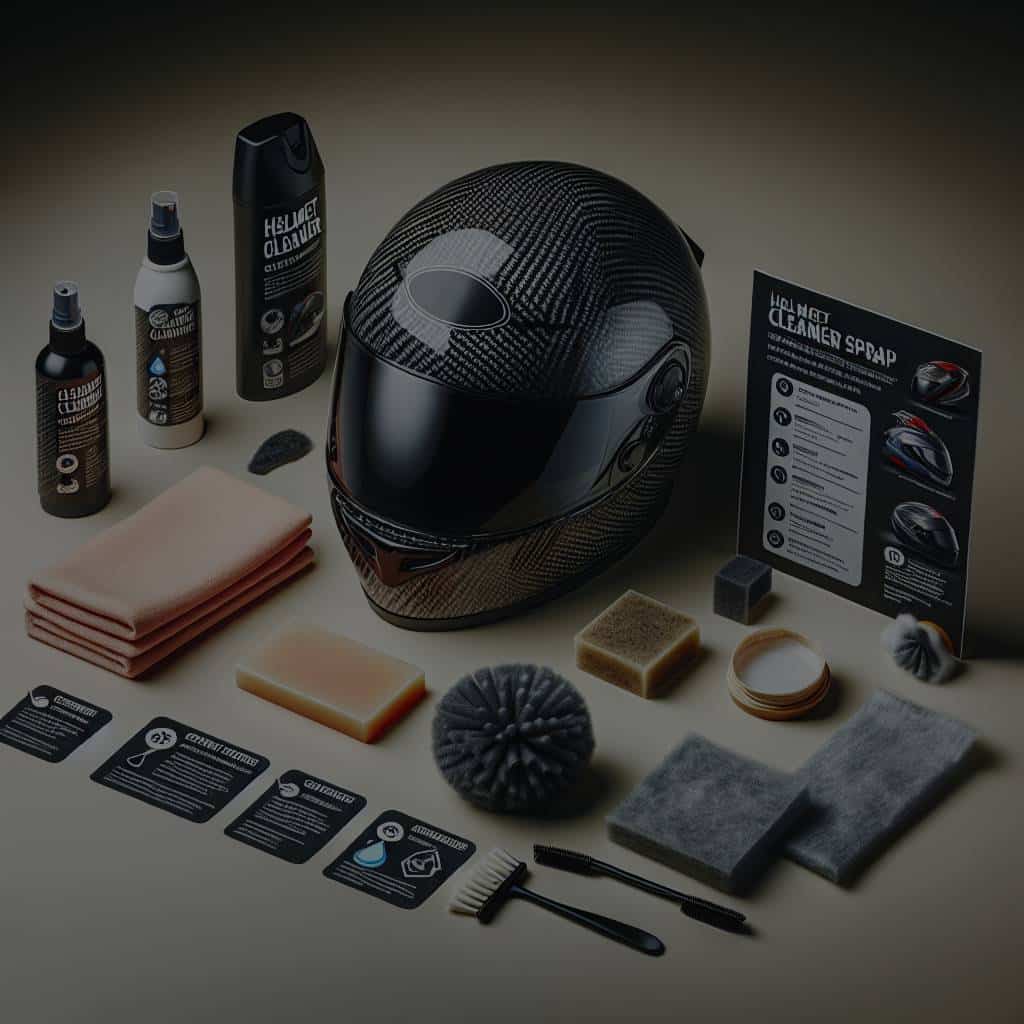Your motorcycle helmet is more than just a piece of safety equipment – it’s an extension of your personal identity on the road. A clean, well-maintained helmet not only ensures your safety, but also makes a strong personal statement. However, the cleaning process can be challenging, especially when dealing with carbon fiber helmets. Despite their robustness and high durability, these helmets require careful cleaning to prevent unwanted damage and extend their lifespan. In this article, we will guide you through the best cleaning methods for carbon fiber motorcycle helmets, ensuring your road companion remains pristine and protective.
Understanding Your Helmet’s Anatomy
To effectively clean your motorcycle helmet, it’s crucial to understand its components. A typical helmet consists of an exterior shell, a visor, and an interior liner. The shell is often made from materials such as carbon fiber, fiberglass, or polycarbonate, while the liner is usually made of foam and fabric materials for comfort. The visor, usually crafted from polycarbonate, provides visibility and protection from wind or debris.
Have you seen this : How to Install a Performance Chip in a Chevrolet Corvette C7 for Improved Torque?
Understanding the different materials used in your helmet helps you choose the appropriate cleaning methods and products. In the case of carbon fiber helmets, delicate handling and specific cleaning products are vital to prevent damage and ensure optimum hygiene and safety.
Cleaning the Exterior Shell
The exterior shell of your motorcycle helmet is exposed to various elements such as dust, bugs, and road grime. When left uncleaned, these substances can slowly damage the helmet’s shell and potentially compromise its protective capabilities.
Also read : What Are the Best Aftermarket Pedals for Improved Grip in a Porsche Boxster?
To clean the shell, start by removing loose dirt and dust with a soft cloth or sponge. Dampen the cloth slightly with warm water and gently wipe the surface. Avoid scrubbing too hard as it can scratch the carbon fiber.
For stubborn stains, a helmet-friendly cleaner such as a mild soap solution can be used. Avoid harsh detergents or chemicals as they can cause fading or weakening of the shell. After application, rinse thoroughly with water to remove any soap residue, as it can cause discoloration if left to dry. Always air-dry your helmet after cleaning to prevent moisture buildup, which can lead to mold or mildew.
Taking Care of the Visor
The visor of your helmet provides clear visibility, which is critical for safe riding. Regular cleaning helps maintain clear vision and prevents scratch marks that can impair your sight.
To clean the visor, first remove it from the helmet if possible. Rinse it under warm water to remove loose dust and dirt. Then, apply a small amount of soap solution on a soft cloth and gently clean the visor.
Avoid using paper towels or rough cloths as they can scratch the surface. Also, steer clear of window cleaners or household cleaning products as they can harm the visor’s anti-fog and anti-scratch coatings. Rinse thoroughly after cleaning to remove all soap traces. Once clean, dry it with a microfiber towel or air-dry it before reinstalling.
Interior Liner Cleaning
The interior liner of your helmet absorbs sweat and skin oils, making it a breeding ground for bacteria over time. Regular cleaning ensures hygiene and extends the liner’s life.
Some helmets, like AGV, come with removable liners, making the cleaning process easier. Check your helmet’s user manual for instructions on how to remove the liner. If your liner isn’t removable, you can still clean it while it’s in the helmet.
For removable liners, hand-washing is the safest method. Use a mild soap or a special helmet liner detergent and warm water to gently clean the liner. Rinely thoroughly to remove all soap. Do not wring the liner as it may damage the foam padding. Instead, press out the excess water and let it air-dry.
For non-removable liners, use a helmet cleaning spray. Spritz it on the liner and let it sit for a few minutes. Then, using a small cleaning brush, gently scrub the liner. Wipe clean with a damp cloth and let it air-dry.
Remember, improper drying can result in a foul smell or mold growth. Therefore, ensure your helmet is completely dry before using it again.
Helmet Maintenance and Protection
Regular cleaning is only half the battle in maintaining your helmet’s longevity. Protecting it from potential damage is equally important. Always store your helmet in a cool, dry place and avoid exposing it to direct sunlight, which can cause the materials to degrade over time. Utilize helmet bags or covers to protect it from dust and scratches.
Also, inspect your helmet regularly for any signs of wear and tear. If you notice any visible cracks, reduced padding, or a loose strap, it’s time to consider replacing your helmet to ensure your safety on the road.
In conclusion, a clean and well-maintained helmet is not just about aesthetics. It directly impacts your safety and the overall riding experience. Invest time and effort into caring for your helmet, and it will serve you well in return.
Cleaning Tips for Different Helmet Parts
Knowing how to clean different parts of your helmet is crucial for maintaining your helmet in a good condition. The main parts of a helmet that require cleaning include the exterior shell, visor, and interior lining.
For the exterior shell, use a soft, damp cloth to gently remove the dirt and dust. Apply a helmet cleaner or a mild soap solution to eliminate stubborn stains, ensuring to rinse thoroughly afterwards to avoid residue and discoloration. Air dry your helmet to prevent moisture buildup which can lead to mold or mildew.
To clean your helmet’s visor, remove it from the helmet if possible and rinse it under warm water. Using a soft cloth, apply a small amount of soap solution to clean the visor, ensuring not to use harsh chemicals that could damage its anti-fog and anti-scratch coatings. Rinse thoroughly and dry with a soft cloth or let it air-dry before reattaching it to the helmet.
The interior lining of your helmet is a hotspot for bacteria due to the absorption of sweat and skin oils. If the lining is removable, hand wash it with mild soap and warm water, ensuring to air-dry thoroughly. For non-removable liners, use a helmet cleaning spray and scrub gently with a small cleaning brush.
Ensuring the Longevity of Your Helmet
Taking care of your motorcycle helmet is not just about cleaning, but also about regular maintenance and protection. To prolong the lifespan of your helmet, there are a few practices you should consider.
Always store your helmet in a cool, dry place to protect it from extreme temperatures and moisture that can degrade its materials. Additionally, avoid exposing it to direct sunlight for extended periods. Utilize a helmet bag or cover for added protection against dust and scratches.
Regular inspection is key to spotting early signs of damage. If you notice any cracks, reduced padding, or a loose strap, it’s safe to say it’s time to invest in a new helmet. Remember, your safety is paramount, and a compromised helmet can jeopardize that.
Conclusion: The Importance of Helmet Care
Keeping your carbon fiber motorcycle helmet clean and well-maintained is essential for numerous reasons. Not only does it ensure the longevity of your helmet, but it also significantly contributes to your safety on the road. A clean visor provides clear visibility, a clean shell maintains the helmet’s protective capability, and a clean interior liner ensures hygiene.
Moreover, investing time in your helmet care reflects your personality and respect for your riding gear. Just as you take care of your motorcycle, your helmet deserves equal attention as it plays a crucial role in your riding experience.
Although cleaning and maintaining a carbon fiber helmet may require a bit of effort, the benefits, in the long run, make it worth your while. With the right cleaning materials and methods, your helmet can stay in top condition, providing you with safety and style for your road adventures. So, get that soft cloth, mild soap, and warm water ready, and give your helmet the care it deserves!






